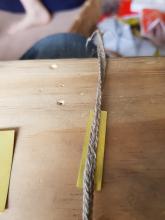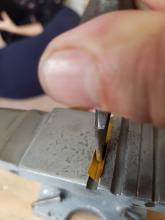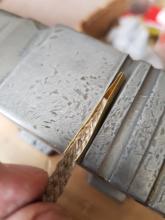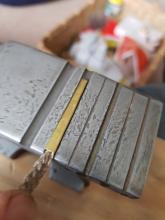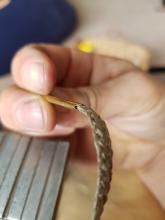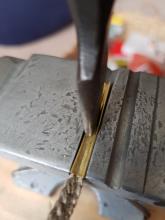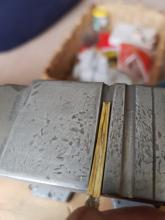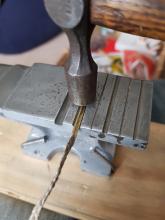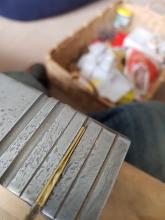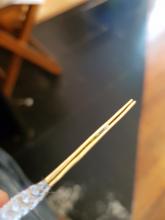Aaaany day now I'll write some more stuff here :)
Key points:
- I think aglets were made on the cord, not separately (apart from the decorative ones)
- I haven't seen any evidence that they were sewn on afterwards
- Type 1 aglets sometimes have overlapped edges, this is probably from a slightly large piece of metal being used
- Type 1 aglets are sometimes pinned (some with 2 pins), type 2 ones aren't (haven't seen any evidence that they were, yet)
- Type 2 aglets seem to work well on flat cord/ribbon
Type 1 (butted or overlapped seam, may be pinned):
- Cut trapezoid of brass
- Press initial curve into it with grooved anvil and either a cross-pein hammer, or a shaped wedge
- Insert cord/thong to about 2/3rds of length (probably not all the way to the point, so it can taper)
- Curve edges to meet in teardrop shape
- Tap butted edges down to form cylinder
- Use an awl to make a hole (or two; many extant pinned aglets seem to have two pins) through the aglet
- Push some wire (iron typically, some possible evidence for copper wire) through the hole, and trim so that it just pokes out both sides
- Peen ends of wire over
This takes me about a minute and a half per aglet, excluding cutting the brass trapezoids (which doesn't take long, but does involve putting down one set of tools and picking up another). It's possible that pre-forming them into the initial curves as well might speed up the process if you were making a lot of them, and I expect to get this down to about a minute per aglet with practice.
Type 2 (rolled in edge seam, no pinning)
| Cut trapezoid of brass | |
|
Press initial curve into it with grooved anvil and either a cross-pein hammer, or a shaped wedge |
|
| Insert cord/thong to about 2/3rds of length (probably not all the way to the point, so it can taper) | |
| Curve edges to not quite meet in teardrop shape |
|
|
Flatten into D-shaped cross-section |
|
| Use cross-pein or shaped wedge to push edges down past each other towards cord, ideally in a slightly oversized groove so that the cord becomes just visible again between the flattened in edges (i.e. they're not overlapping) |
|
|
Roll edges in |
|
|
Tap butted rolled edge down to form cylinder |
This takes me just under two minutes per aglet at the moment, excluding cutting the blanks.
